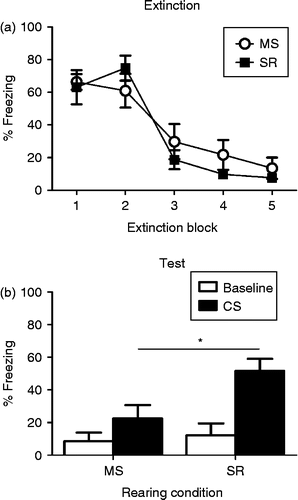Figures & data
Figure 1. (a) Mean ( ± SEM) levels of CS-elicited freezing during five blocks (six CS presentations in each block) of extinction training in MS (open circles; n = 11) and SR (closed squares, n = 10) adolescent rats. Regardless of rearing condition, rats showed high levels of freezing at the start of extinction that decreased across blocks. (b) Mean ( ± SEM) levels of baseline (white bars) and CS-elicited (black bars) freezing in MS and SR rats at test. * indicates a significant difference in CS-elicited freezing between groups. Baseline fear is low in both rearing conditions but higher levels of CS-elicited fear are present in the SR adolescent rats than the MS adolescent rats.

Figure 2. (a) Mean ( ± SEM) levels of CS-elicited freezing during five blocks (six CS presentations in each block) of extinction training in MS (open circles) adolescent rats. Rats show high levels of fear at the beginning of extinction that decreases across blocks. (b) Mean ( ± SEM) levels of baseline (white bars) and CS-elicited (black bars) freezing in MS rats tested in the same (n = 8) or different (n = 8) context as extinction training. * indicates a significant difference in CS-elicited freezing between groups. Baseline fear at test is low, regardless of context, but higher levels of CS-elicited fear are present in the MS rats tested in a different context to extinction training.

Figure 3. (a) Mean ( ± SEM) levels of CS-elicited freezing during five blocks (six CS presentations in each block) of extinction training in MS (open circles, n = 7) and SR (closed squares; n = 9) pre-adolescent rats. Rats show high, and similar, levels of fear at the beginning of extinction that decreases across blocks. (b) Mean ( ± SEM) levels of baseline (white bars) and CS-elicited (black bars) freezing in MS and SR rats during test. * indicates a significant difference in CS-elicited freezing between groups. Baseline fear is low in both rearing conditions but higher levels of CS-elicited fear are present in MS pre-adolescent rats than in SR rats of the same age.
